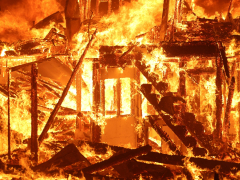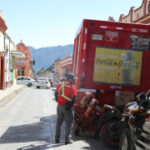California has been placed in a state of emergency and two people have been reported dead as wildfires which began on Tuesday rip across metropolitan Los Angeles, triggering evacuations and power outages.
The most populous state in the United States, California has frequently been swept by wildfires, especially in the south.
Here is what we know about the fires, their impact and the latest news on the ground.
Where and when did the wildfires in Los Angeles begin?
At 10: 30am (18: 30GMT) on Tuesday, the first wildfire began in the Pacific Palisades area of Los Angeles, according to the California Department of Forestry and Fire Protection (Cal Fire).
This affluent neighbourhood, which lies between the Santa Monica mountains and the Pacific Ocean, is about 32 kilometres (20 miles) west of downtown Los Angeles.

Which areas of LA have wildfires affected and how much of the area has been burned?
Nearly 1,200 hectares (3,000 acres) of land had been burned in the Pacific Palisades fire by Tuesday evening, according to Cal Fire.
Around 6pm (02: 00 GMT) on Tuesday, a second blaze, called the Eaton Fire, broke out some 50km (30 miles) inland near Pasadena and has grown to 901 hectares (2,227 acres) as of Wednesday morning
A third blaze named the Hurst Fire also started in Sylmar, in the San Fernando Valley northwest of Los Angeles.
Together, the three fires have burned through 2,285 hectares (5,648 acres).
How many people have been killed in the LA wildfires?
On Wednesday morning, Los Angeles County Fire Chief Anthony Marrone said two fatalities had been reported in the Eaton fire as well as a “high number of significant injuries to residents” in the Palisades blaze.
A fire official told local television station KTLA that one female firefighter had suffered a head injury in the Palisades fire.
No deaths have been reported from the Palisades blaze.
Are the LA wildfires spreading further afield?
Yes, it appears so. US media reported the fires have already spread north, torching homes near Malibu.
Cal Fire said that a newer blaze, dubbed Woodley Fire, began on Wednesday in the Sepulveda Basin area north of Los Angeles and has grown to 30 hectares (75 acres).
Malibu began issuing evacuation orders on Tuesday afternoon and Santa Monica on Tuesday evening.
Have any buildings been damaged?
Approximately 1,000 buildings have been destroyed in the Pacific Palisades, Marrone told reporters on Wednesday.
The Palisades fire also burned some trees and vegetation on the grounds of the Getty Villa Museum, one of the world’s wealthiest art museums, which houses artifacts from ancient Greece and Rome.
In a post on social media platform X, the museum said no structures had caught fire, and “staff and the collection remain safe”.
The Eaton fire engulfed a McDonald’s restaurant and the Pasadena Jewish Temple and Centre, but Melissa Levy, the temple’s executive director, told The New York Times that the temple’s staff safely evacuated with their holy books, including Torahs.
American actor James Woods reported damage to his Pacific Palisades home.
All the smoke detectors are going off in our house and transmitting to our iPhones.
I couldn’t believe our lovely little home in the hills held on this long. It feels like losing a loved one.
— James Woods (@RealJamesWoods) January 8, 2025
How do Santa Ana winds contribute to California’s wildfire?
Officials have not confirmed the cause of these fires. However, winter-time wildfires are not unusual in California because of the region’s “Santa Ana” winds, which dry out vegetation and make them more susceptible to fire.
These are dry, warm and strong winds common in Southern California during the cooler months due to conditions created by atmospheric pressure changes and cooler temperatures of the season.
Santa Ana winds form when high pressure over the Great Basin, a large, dry region in the western US, forces air to flow towards the coast. As the air sinks through mountain ranges and valleys, it loses moisture, compresses and accelerates, becoming warmer and faster.
The region’s geography, including the orientation of the mountains and valleys, directs the winds towards Southern California and the Pacific Ocean coast.
Experts say this winter has been particularly threatening.
“We really haven’t seen a season as dry as this one follow a season as wet as the previous one – all of that extra abundant growth of grass and vegetation followed immediately by a wind event of this magnitude while it’s still so incredibly dry,” Daniel Swain, a climate scientist at University of California, Los Angeles, said on a livestream on Monday.
The intense Santa Ana winds have been linked to some of Southern California’s worst wildfires, including the Franklin fire in December 2024 which scorched more than 1,600 hectares (4,000 acres) of the Malibu area, damaged or destroyed almost 50 homes, and was fully contained nine days after it broke out.
On Saturday, t




